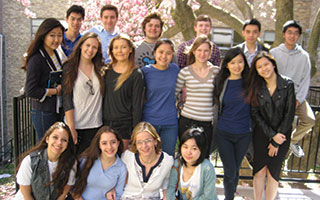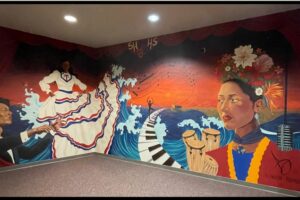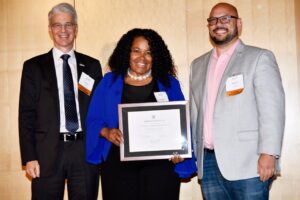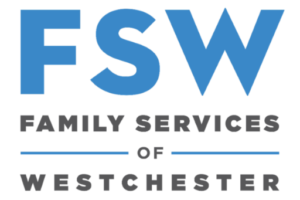 When driving to work over the Tappan Zee bridge, I often glance up at the dome of Education First International Academy (EF IA) and think about how a slice of the whole world resides there on that hill. Each day students from more than 40 nations and educators from more than a dozen countries learn and live together.
When driving to work over the Tappan Zee bridge, I often glance up at the dome of Education First International Academy (EF IA) and think about how a slice of the whole world resides there on that hill. Each day students from more than 40 nations and educators from more than a dozen countries learn and live together.
The students at EFIA recognize and celebrate this singular feature. A senior from Hong Kong in my literature class, which has students from Norway, Russia, Malaysia, Brazil, Taiwan, China, England, Vietnam, Venezuela, and Korea, told me that now, after studying at EF he views a world map differently than he did before, saying he no longer simply sees one foreign country after another. When I pressed him to explain a little more he added, “Well, when I see Norway, I see myself skiing with Nicolai and Benjamin in the endless woods; when I see Brazil, I see Luiza and Mariana dancing and laughing in shorts and flip-flops; when I see Indonesia, I see Esa serving delicious fruit drinks at the Culture Fair; when I see Korea, I see CJ in her Hanbok during the Lunar New Year Celebration; and when I see Russia, I think about how hard it was for Anna to teach me to write the Cyrillic alphabet.” He smiled and continued, “So…basically when I look at the map of the world, now I see my friends.”
EFIA’s curriculum is indeed rigorous and competitive—all the juniors and seniors are enrolled in the International Baccalaureate program—and in 2013, the school’s fifth year in
existence, seniors were accepted into prestigious colleges and universities including Williams, Vassar, UCLA, University of Michigan, Emory, University of Miami, Sarah Lawrence and NYU. Yet the chief reason EFIA’s enrollment continues to expand—even while the area’s other private institutions’ numbers are shrinking—is this international component.
Perhaps on account of the rich fabric of experiences and knowledge, the global community naturally evokes kindness. It also generates not only a tolerance but also a genuine curiosity and relishing of differences. An 11th grade American student, who lives in Irvington, is grateful for this harmony, which is often elusive in the high school atmosphere: “EF’s social life is wonderful and different. Maybe since we all met in high school and all have such different backgrounds, there are no cliques at EF.” This year’s valedictorian, a native of Moscow, echoes this sentiment: “It has some unifying quality. When we all discuss world news/problems of racism/favorite food, we can share different experiences, but our approach and values will be strikingly similar.”
As a literature teacher and literary magazine advisor at the school, I’ve witnessed the effects of this global color through the students’ creations and interactions. EFIA’s literary magazine displays this prominent feature, offering pieces ranging from topics including Mother’s Day traditions in Vietnam to a Russian student’s meditation on the surprising challenges of being trilingual (Chinese, Russian, and English). The magazine also offers essays written in Bengali, Thai, Norwegian, and Chinese. This year the students participated in generating a school-wide writing competition honoring one of the founders of EFIA, Dr. Claudia Trew. The winners, who hailed from Brazil, Norway, and Russia, worked with Sarah Lawrence professor and award-winning American poet Jeff McDaniel, honing their writing and learning new skills. Professor McDaniel commented not only on the strength of their writing but also on their mature openness to human experience.
On a daily basis, students surprise their teachers with their complexity of spirit and intellect. Recently, I asked my 11th graders to consider a time when they were unable to achieve a goal on account of an external or internal limitation. Preparing to respond to the usual challenges like distractions, self-doubt, or laziness, I was humbled by one student from Cameroon, who had been living in Mali for the previous two years. He shared with the class, “I finally had earned a 4.0, but I couldn’t finish the year because we had to move on account of the coup d’etat.” These sort of perspective-expanding responses are the norm rather than the exception.
This same variety expands to the faculty’s lunch table. Conversations are sprawling in nature: Mr. Kwabi pines for the “FuFu” of his home country of Ghana; Ms. Jensen reminisces about time spent swimming in the icy North Sea of Norway; Dr. Pohland shares her pride in German literature, giving her colleagues specific details about the life of Goethe; Ms. Yoo laughs about the pervasive nature of K-pop in today’s culture.
Often when I finish a class, a faculty lunch, or a school day, I recall one of the final literary magazine meetings prior to the December break. The members wrote a community poem on “home,” inspired by Hermann Hesse’s reflections on the topic. The author’s following words resonated with the students as they strove to write their own thoughts about the concept: “One never reaches home, but wherever friendly paths intersect, the whole world looks like home for a time.” One of the chief editors of the magazine and the student who now sees a map of friends rather than of countries, wrote lines that capture the essence of EFIA’s gift to its students and faculty alike: “Home is within you (within me?)/But as I leave footprints all over the world/Home becomes everywhere.”
Education First International Academy, a five-year-old global community overlooking the Hudson River, continues to grow and thrive, ultimately seeking and finding joy and
respect—indeed, a home!—not in spite of, but because, of its members’ differences.
Ms. Sara Walsh
International Baccalaureate
English Teacher






